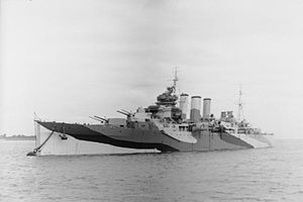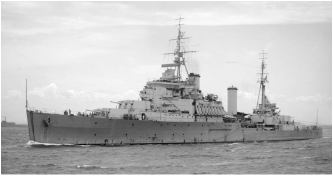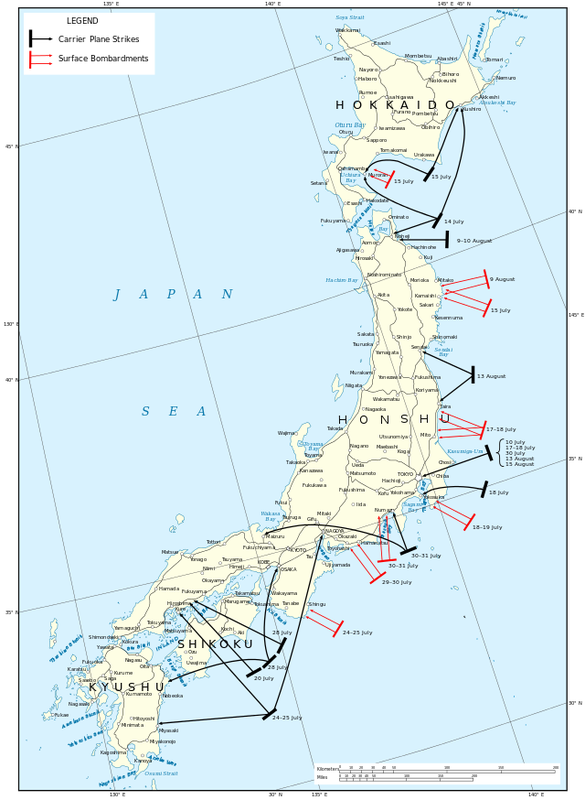| Grandads war: 1942-1946 |
Grandads war: 1942-46 HMNZS Gambia
Jack Maben (my Grandad - 19xx - 198x) was born in xxxxx and grew up in Kent with his younger brother Kenny who sadly died of pneumonia shortly after the end of the war at the age of xxx. He joined the Royal Marines on xxxxxxx shortly after the outbreak of WW2 after previously training as a barber. He married Elizabeth (Betty) on xxxx and they enjoyed a short honeymoon in Torquay before he re-joined the war.
HMS Shropshire

Grandad served on HMS Shropshire from 7.1.42 to 5.4.43 on South Atlantic convoy escort duties. HMS Shropshire was a Royal Navy (RN) heavy cruiser of the London sub-class of County class cruisers. She is the only warship to have been named after Shropshire, England. Completed in 1929, Shropshire served with the RN until April 1943, when she was transferred to the Royal Australian Navy (RAN) following the loss of sister ship HMAS Canberra.
During Grandads time serving on board HMS Shropshire included seal trials and 'ammunitioning' in early 1942 before joining the Atlantic convoys protecting trade routes between Britain and South Africa with regular stopovers in Freetown, Capetown, Simonstown and Durban.
During Grandads time serving on board HMS Shropshire included seal trials and 'ammunitioning' in early 1942 before joining the Atlantic convoys protecting trade routes between Britain and South Africa with regular stopovers in Freetown, Capetown, Simonstown and Durban.
HMNZS Gambia
 HMNZS Gambia 1942
HMNZS Gambia 1942
Grandad joined the crew after a re-fit at Liverpool between June and September 1943, following which she operated anti-blockade runner patrols in the Bay of Biscay in December, as part of Operation Stonewall. Because New Zealand's two other cruisers of the time, HMNZS Leander and HMNZS Achilles were damaged, it was decided in discussions with the Royal Navy Admiralty that HMS Gambia would be re-commissioned as HMNZS Gambia, for the use of the Royal New Zealand Navy. Gambia was transferred to the Royal New Zealand Navy on 22 September 1943.
Gambia served with the British Pacific Fleet, and participated in attacks on Japanese positions throughout the Pacific. In February 1944 she was searching for blockade runners in the Cocos Islands area. She also supported a series of carrier raids against oil installations and airfields. She saw action off Okinawa, Formosa and Japan and took part in the bombardment of the Japanese city of Kamaishi on 9 August. She was under attack by Japanese aircraft at the time that a ceasefire was announced, and so has the honour of firing some of the last shots of World War II.
She was present on 2 September 1945 in Tokyo Bay for the signing of Japanese Instrument of Surrender. Full details of Gambias movements during WW2 are available here.
Gambia served with the British Pacific Fleet, and participated in attacks on Japanese positions throughout the Pacific. In February 1944 she was searching for blockade runners in the Cocos Islands area. She also supported a series of carrier raids against oil installations and airfields. She saw action off Okinawa, Formosa and Japan and took part in the bombardment of the Japanese city of Kamaishi on 9 August. She was under attack by Japanese aircraft at the time that a ceasefire was announced, and so has the honour of firing some of the last shots of World War II.
She was present on 2 September 1945 in Tokyo Bay for the signing of Japanese Instrument of Surrender. Full details of Gambias movements during WW2 are available here.
Life at sea
blah, blah, blah
Keeping in Touch with home
blah blah
1943 - 1945
the last weeks of war
|
Battle of Okinawa: During the last weeks of World War II, warships of the United States Navy, Britain's Royal Navy, and the Royal New Zealand Navy bombarded several cities and industrial facilities in Japan. These bombardments caused heavy damage to several of the factories targeted, as well as nearby civilian areas. The Japanese military did not attempt to attack the Allied fleet, and none of the warships involved in the bombardments suffered any damage. As many as 1,739 Japanese were killed in the attacks, and up to another 1,497 were wounded.
As part of these operations off northern Japan, Kamaishi was bombarded again on 9 August by the ships which had previously bombarded the city in July with the addition of the heavy cruisers USS Boston and Saint Paul, British light cruiser HMS Newfoundland, Royal New Zealand Navy light cruiser HMNZS Gambia and destroyers HMS Terpsichore, Termagant and Tenacious. The Allied force opened fire on the iron works and docks at Kamaishi at 12:54 and the bombardment lasted for almost two hours from an average range of 14,000 yd (13,000 m). During this time, the ships made four passes outside of Kamaishi harbor and fired 803 16-inch (410 mm) shells, 1,383 8-inch (200 mm) shells and 733 6-inch (150 mm) shells. Gambia fired the final shots of the attack. During the bombardment, several Japanese aircraft approached the Allied ships and two were shot down by Allied naval fighters The ship was attacked about 200 miles off the Japanese coast by a Japanese fighter aircraft on 15 Aug 1945, the day hostilities against the Japanese ceased. Although some 180 men were on deck at the time being addressed by Lieutenant Commander Davis Goff none were hurt. An unknown Allied aircraft shot the Japanese fighter down in time and bits of the plane landed on the quarterdeck. |
Liberation of tokyo
more text here...

